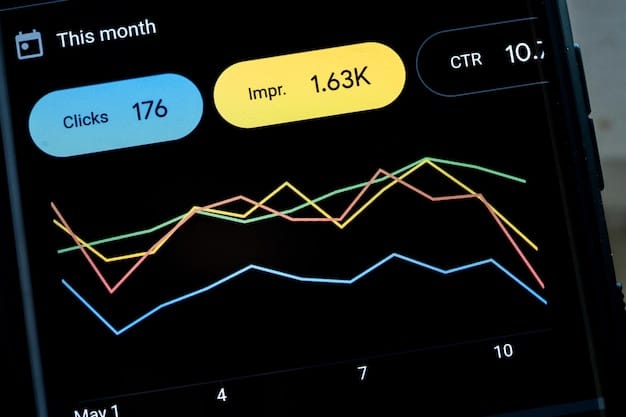Are You Overpaying? A Guide to Comparing Prices Across US Online Retailers

Are you overpaying for online purchases in the US? This guide provides practical strategies for comparing prices across various online retailers, helping you find the best deals and avoid overspending, ensuring you get the most value for your money.
Are you tired of wondering if you’re getting the best deal when shopping online? The internet is a vast marketplace, and it’s easy to feel lost in a sea of prices. This comprehensive guide, “**Are You Overpaying? A Guide to Comparing Prices Across US Online Retailers**,” is designed to equip you with the knowledge and tools to navigate the online shopping landscape effectively and ensure you never pay more than you have to.
Why Comparing Prices Matters
In today’s digital age, online shopping has become increasingly popular due to its convenience and accessibility. However, with countless retailers vying for your attention, it’s easy to fall into the trap of overpaying for products. Understanding why comparing prices matters is the first step toward becoming a savvy online shopper.
Comparing prices isn’t just about saving a few bucks; it’s about making informed purchasing decisions and getting the best possible value for your money. Here’s why it’s so important:
Maximizing Your Budget
Every dollar saved is a dollar that can be used elsewhere. By comparing prices, you ensure that you’re not wasting money on inflated costs, allowing you to allocate your funds to other priorities.
Identifying Hidden Fees
Sometimes, the listed price isn’t the final price. Comparing prices allows you to factor in shipping costs, taxes, and other fees that can significantly increase the total cost.
Avoiding Impulse Buys
When you take the time to compare prices, you’re less likely to make hasty, uninformed decisions driven by impulse. This practice promotes mindful spending and helps you avoid buyer’s remorse.

Here’s are some key benefits of price comparison:
- Finding the Best Deals: Obvious, but crucial. Comparison helps you spot discounts and sales.
- Uncovering Alternatives: You might find similar products at lower prices.
- Supporting Ethical Retailers: You can choose retailers with fair pricing and better practices.
In summary, comparing prices is an essential practice for anyone looking to make the most of their online shopping experience. It empowers you to make smarter decisions, save money, and support businesses that offer genuine value.
Tools and Websites for Price Comparison
The internet offers a plethora of tools and websites designed to make price comparison easier and more efficient. These resources can save you time and effort, providing comprehensive overviews of prices across multiple retailers.
Here are some of the most popular and effective tools and websites for price comparison:
Google Shopping
Google Shopping is a powerful tool that aggregates product listings from various retailers, allowing you to compare prices, read reviews, and find the best deals directly from Google’s search results.
PriceGrabber
PriceGrabber is a dedicated price comparison website that focuses on a wide range of products, from electronics to home goods. It offers detailed product information and price history, helping you make informed decisions.
CamelCamelCamel
Specifically for Amazon, CamelCamelCamel tracks price changes over time, allowing you to see historical price trends and identify the best time to buy a product. It also sends price alerts so you never miss a deal.

These tools offer unique features that simplify price comparison:
- Browser Extensions: Automatically compare prices while you browse.
- Mobile Apps: Compare prices on the go, directly from your smartphone.
- Price Alerts: Receive notifications when prices drop on your desired items.
Leveraging these tools and websites can significantly streamline your price comparison process, ensuring you always get the best possible deal on your online purchases.
Strategies for Effective Price Comparison
While having the right tools is important, knowing how to use them effectively is equally crucial. Implementing strategic approaches to price comparison can maximize your savings and ensure you’re making informed decisions.
Here are some strategies for effective price comparison:
Consider Shipping Costs
Always factor in shipping costs when comparing prices. A product might be cheaper on one website, but high shipping fees can negate the savings. Look for retailers that offer free shipping or have reasonable shipping rates.
Check for Discounts and Coupons
Before making a purchase, search for available discounts and coupons. Many retailers offer promotional codes that can significantly reduce the price. Use browser extensions or websites dedicated to coupon hunting to find these deals.
Read Reviews
Price isn’t the only factor to consider. Read reviews to assess the quality and reliability of the product and the retailer. This will help you avoid buying from untrustworthy sources or purchasing subpar items.
Effective price comparison involves more than just finding the lowest number:
- Factor in Time: Is the lower price worth a longer delivery time?
- Evaluate Return Policies: Ensure you can return the item if needed.
- Check Payment Methods: Some retailers offer discounts for specific payment methods.
By integrating these strategies into your online shopping routine, you can ensure that you’re not only finding the best prices but also making smart, well-informed purchasing decisions.
Understanding Price Fluctuations
Prices for online products can fluctuate significantly due to various factors. Understanding these price fluctuations can help you time your purchases strategically and save money.
Here are some common reasons for price fluctuations:
Seasonal Sales
Many retailers offer significant discounts during seasonal sales events like Black Friday, Cyber Monday, and holiday sales. Keep an eye out for these events and plan your purchases accordingly.
Dynamic Pricing
Some retailers use dynamic pricing algorithms that adjust prices based on demand, competitor pricing, and other factors. Prices can change in real-time, so it’s essential to monitor them closely.
Limited-Time Offers
Retailers often run limited-time offers or flash sales to drive sales. These offers can provide substantial savings, but they usually have a short expiration period, so act fast.
Be aware of these price drivers to make informed choices.
- Clearance Events: End-of-season or discontinued items often see major price drops.
- Inventory Levels: Low stock can sometimes lead to higher prices, and vice versa.
- Competitor Actions: Retailers often adjust prices in response to competitors’ sales.
By understanding these factors, you can anticipate price drops and time your purchases to maximize savings.
Avoiding Scams and Fake Products
While online shopping offers numerous benefits, it’s also important to be aware of potential scams and counterfeit products. Protecting yourself from these risks is crucial for a safe and satisfying online shopping experience.
Here are some tips for avoiding scams and fake products:
Buy from Reputable Retailers
Stick to well-known and reputable retailers with a proven track record. Avoid buying from unfamiliar websites or sellers with questionable reviews.
Check Product Authenticity
Carefully examine product descriptions and images to ensure they match the authentic product. Look for inconsistencies, such as misspelled words, blurry images, or unrealistic pricing.
Use Secure Payment Methods
Always use secure payment methods like credit cards or PayPal, which offer buyer protection in case of fraud or disputes. Avoid using cash or wire transfers, as these methods are riskier.
Safeguarding yourself online involves several key steps:
- Verify Seller Information: Check for contact details and physical addresses.
- Read Customer Reviews: Look for patterns of complaints or suspicious activity.
- Be Wary of Deals That Seem Too Good to Be True: If a price is significantly lower than the market average, it could be a scam.
By staying vigilant and following these guidelines, you can significantly reduce your risk of encountering scams and fake products online.
Leveraging Price Matching Policies
Many retailers offer price matching policies, which can be a powerful tool for saving money. Understanding and leveraging these policies can ensure you always get the best available price.
Here’s how to leverage price-matching policies:
Understand the Terms and Conditions
Before attempting to price match, carefully read the terms and conditions of the retailer’s policy. Pay attention to any restrictions, such as eligible products, competing retailers, and required documentation.
Gather Evidence
When requesting a price match, provide clear evidence of the lower price, such as a screenshot of the competitor’s website or a printed advertisement.
Contact Customer Service
Contact the retailer’s customer service department and request a price match. Be polite and professional, and provide all the necessary information and documentation.
Price matching can be a game-changer when you shop strategically.
- Know Which Retailers Offer Price Matching: Major stores often have these policies.
- Check for Exclusions: Some items or competitors might be excluded.
- Keep an Eye on Promotions: Policies may change during promotional periods.
By understanding and utilizing price matching policies, you can confidently shop knowing you’re getting the best possible deal.
| Key Point | Brief Description |
|---|---|
| 💰 Price Comparison Tools | Use Google Shopping, PriceGrabber, etc., to find the best deals. |
| 🚚 Shipping Costs | Always factor in shipping costs to avoid overpaying. |
| 🧐 Product Authenticity | Verify product authenticity to avoid scams and fake products. |
| 🤝 Price Matching Policies | Leverage price matching to ensure you get the best available price. |
Frequently Asked Questions (FAQs)
▼
Popular options include Google Shopping, PriceGrabber, and CamelCamelCamel. These sites aggregate listings from various retailers, allowing you to quickly compare prices and find the best deals.
▼
Always check the shipping fees before making a purchase. Some retailers offer free shipping above a certain order value, which can significantly impact the overall cost. Look for these deals to save money.
▼
Contact the retailer and inquire about their price adjustment policy. Many stores offer price adjustments within a certain timeframe if you find the same product for less elsewhere. Provide proof of the lower price.
▼
Stick to reputable retailers, check product authenticity, and use secure payment methods like credit cards or PayPal. Be wary of deals that seem too good to be true, and always read customer reviews.
▼
Yes, browser extensions can automatically compare prices while you browse, saving you time and effort. They often alert you to lower prices on other websites and can be a valuable tool for finding the best deals.
Conclusion
In conclusion, by adopting a strategic approach to online shopping, leveraging the right tools and websites, and staying informed about price fluctuations and potential scams, you can confidently navigate the online marketplace and ensure you’re always getting the best possible value for your money. **Are You Overpaying? A Guide to Comparing Prices Across US Online Retailers** provides you with the knowledge to make smart buying decisions.





